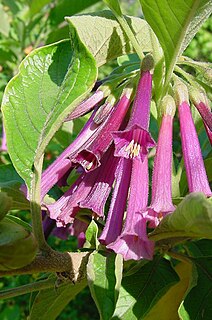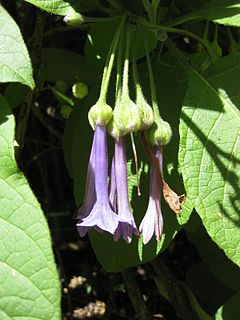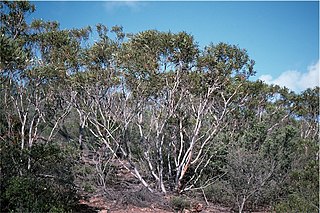
Iochroma is a genus of about 34 species of shrubs and small trees belonging to the nightshade family Solanaceae and found in the forests of South America and Mexico. They range from Colombia to Argentina or when certain species are excluded from Colombia to Peru. Their hummingbird-pollinated flowers are tubular or trumpet-shaped, and may be blue, purple, red, yellow, or white, becoming pulpy berries. The cupular (cup-shaped) calyx is inflated in some species. The leaves are alternate, simple, and entire.
Abarema lehmannii is a species of legume in the family Fabaceae. It is endemic to the Cordillera Central in Antioquia, Colombia. It can be found at the margins of humid montane forests.
Zygia lehmannii is a species of legume in the family Fabaceae. It is found only in Colombia.
Aiouea lehmannii is a species of plant in the family Lauraceae. It is found in Brazil and Colombia.
Iochroma brevistamineum is a species of plant in the family Solanaceae. It is endemic to Ecuador.
Iochroma longipes is a species of plant in the family Solanaceae. It is endemic to Ecuador.
Lysipomia lehmannii is a species of plant in the family Campanulaceae. It is endemic to Ecuador. Its natural habitats are subtropical or tropical moist montane forests and subtropical or tropical high-altitude grassland. It is threatened by habitat loss.
Oreopanax lehmannii is a species of plant in the family Araliaceae. It is endemic to Ecuador. Its natural habitats are subtropical or tropical moist montane forests and subtropical or tropical high-altitude shrubland. It is threatened by habitat loss.
Peperomia lehmannii is a species of plant in the family Piperaceae. It is endemic to Ecuador.

Gastrolobium lehmannii or Cranbrook Pea is a vulnerable shrub in the family Fabaceae which is endemic to an area of Western Australia.

Iochroma arborescens is a species of flowering plant in the genus Iochroma, belonging to the nightshade family Solanaceae. Formerly it was considered the single species in the monotypic genus Acnistus. Common names include gallinero, mata-gallina, fruta-de-sabiá, hollowheart, wild tobacco, siyou, bastard sirio, galán arbóreo, tabaco de monte, nigüito, marieneira, güitite, and tabak djab.
Pitcairnia lehmannii is a species of flowering plant in the Bromeliaceae family. This species is native to Ecuador.

Encephalartos lehmannii is a low-growing palm-like cycad in the family Zamiaceae. It is commonly known as the Karoo cycad and is endemic to South Africa. The species name lehmannii commemorates Prof J.G.C. Lehmann, a German botanist who studied the cycads and published a book on them in 1834. This cycad is listed as near threatened in the IUCN Red List of Threatened Species.

Iochroma fuchsioides is an Iochroma species found in Ecuador and Colombia. It was first described in 1848. In addition to the known withanolide D {1}, three new withanolides have been isolated from Iochroma fuchsioides.

Iochroma grandiflorum is an Iochroma species found in Ecuador. It was first described in 1845

The Kamëntsá are an indigenous people of Colombia. They primarily live in the Sibundoy Valley of the Putumayo Department in the south of Colombia.

Iochroma warscewiczii is a shrub in the family Solanaceae. The species, which is native to Peru, was formally described in 1855 by German botanist Eduard August von Regel. It is named for the Polish botanist and explorer Józef Warszewicz Ritter von Rawicz (1812-1866).

Eucalyptus lehmannii, commonly known as bushy yate, is a eucalypt in the myrtle family Myrtaceae endemic to the south-west of Western Australia. It is a small tree with an oval, spreading form and dense foliage which sometimes reaches to the ground. It is widely cultivated in Australia and the United States because of its ornamental shape and decorative flowers, buds and fruit. There has been some confusion about its classification because of its ability to hybridise.
Calothamnus lehmannii, commonly known as dwarf claw flower, is a plant in the myrtle family, Myrtaceae and is endemic to the south-west of Western Australia. It is a low-lying, sometimes ground-hugging shrub with long, thin, cylindrical leaves and clusters of red flowers that are smaller than any others in the genus Calothamnus.

Jacksonia lehmannii is a species of leafless broom-like shrub or small tree in the family Fabaceae that is native to the south west of Western Australia. It was first described by Carl Meissner in 1844. It has no synonyms.









